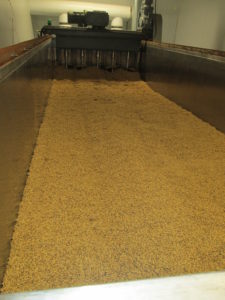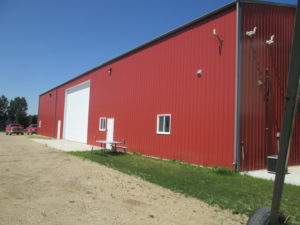Who would have figured? Red Shed Malting operates out of an actual red shed.
Last week I did a quick jaunt south to hit up some of the new breweries that have opened up over the last few weeks (more on the tour in my next post as well). Since I was already working my way down and up Highway 2, I figured I should also make a visit to Red Shed just off the highway near Penhold south of Red Deer (as I mentioned in this post).
I have toured hundreds of breweries in my days but have only seen one malt house – Rahr Malting in Alix. It was impressive in its industrial scale and fine-tuned quality control. I have a decent handle on the malting process – which starts the germination process to transform starches to sugars available to yeast – but am hardly an expert. The technical details are a bit of a mystery to me. I just know I love the results! So stopping by Red Shed was a much-anticipated experience for me.
Joe Hamill, one half of the Hamill brothers who operate Red Shed, showed me around the facility. My first impression was to note just how small it was. Even though I knew they are a micro-operation, producing 2.5 tonnes per batch (Rahr produces more in a day than Red Shed can do in a year), I was still surprised at how small scale and low tech the operation is. It consists, basically, of two cooler-sized rooms each containing a large steel bin. The outer room holds a roaster the size of large commercial washing machine. A side room serves as the lab to ensure the process goes smoothly and things are measured properly. The entire space is likely 5,000 square feet at most (I suck at area estimation).
I over-simplify, of course. The malting rooms are actually constructed to handle both the germination and kilning phases and the roaster, while small, still requires quite a bit of technical know-how. But I wanted to highlight my impressions of the size to drive home the point that this is truly an artisanal, craft-oriented operation. I came away impressed at the Hamill’s ingenuity and determination.
Craft malting is new (very new in these parts) but does seem like the natural extension to the craft beer revolution. If you are going to produce local beer, why not use local malt?
I am a bit surprised (pleasantly) just how fast Red Shed has developed a name and reputation in Alberta. Most Alberta breweries are at least experimenting with their malts and many are actively promoting their releases as “brewed with Red Shed malt”. Not bad for a company that has been operating for just over a year. I think their early success demonstrates the time is right for local craft malting. There are at least three other maltsters in the building process in the province.
The reality is that Red Shed’s product is more expensive – about 50% higher than the big malt houses. That means, practically speaking, their most likely market space is in specialty malts – the darker and more flavourful malts that are added in small portions to add flavour and complexity to a beer. Breweries can likely afford to use slightly more expensive specialty malts since they only comprise five to ten percent of the malt bill.
Plus the base malts made by Rahr and Calgary’s Canada Malting are high quality products (I can say this from personal experience, having used their malts in my homebrewing for years). This is one way in which the malting industry differs from beer. While the large maltsters make big quantities (Rahr can produce about 150,000 tonnes per year, Canada Malting is even bigger), they keep a keen eye on quality. No cutting corners here. Plus they, for the most part, use barley grown in the region. No reason to turn one’s back on them.
The place for Red Shed and other craft malting houses is to provide malts with interesting flavours. Plus they can experiment more given their small batches. The pairing of small craft maltsters with small craft brewers is ideal.
And we should never forget – to return to my recent visit – Red Shed is engaged in a very artisanal, hands-on project. There is minimal mechanization and the Hamill’s have to use their skills and instinct to decide when a malt is ready. I came away with a clear sense of just how intimate the process is for them. They touch every aspect of the malting process personally. Meaning we can trust that their malt is malt made with love.
And you gotta love that.
[Edited to correct a factual error about their location.]



July 17, 2017 at 6:21 PM
Having brewed 30 gallons of libation this summer using exclusively Red Shed Malt – I can attest to the flavour of this grain. It’s been a treat to play with recipes and create several malt forward beers (a brown ale, and a belgian) that really show off the Alberta flavour.
I look forward to the direction Red Shed will take over the next year!
July 18, 2017 at 9:09 AM
I have been really happy to see Red Shed featured in some new beers. I enjoy a malty beer, and where the brewer is going to spend the money for more expensive malt, it is a great signal of what to expect. I have been impressed with the flavors of those beers, but who knows whether that is the malt or the fact that the recipes are malt focused?